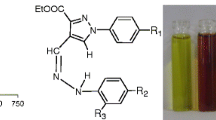Abstract
A new aromatic hydrazone based on pyrene-1-aldehyde was synthesized and characterized by 1H NMR and mass spectrometric analyses. The sensing properties of the hydrazone were studied by absorption and fluorescence studies in the aprotic solvent DMSO. It was capable of visual and fluorescent detection of fluoride over competitive ions (Cl−, Br−, H2PO4 −, AcO−). Moreover, the in-situ prepared iron(III) complex of the hydrazone was investigated as a turn off fluorescent fluoride sensor in aqueous medium by displacement mechanism.









Similar content being viewed by others
References
Gazzano E, Bergandi L, Riganti C, Aldieri E, Doublier S, Costamagna C, Bosia A, Ghigo D (2010) Fluoride effects: the two faces of Janus. Curr Med Chem 17:2431–2441
Ayoob S, Gupta AK (2006) Fluoride in drinking water: a review on the status and stress effects. Crit Rev Env Sc Tech 36:433–487
Zhou Y, Zhang JF, Yoon J (2014) Fluorescence and colorimetric chemosensors for fluoride-ion detection. Chem Rev 114:5511–5571
Gunnlaugsson T, Glynn M, Tocci GM, Kruger PE, Pfeffer FM (2006) Anion recognition and sensing in organic and aqueous media using luminescent and colorimetric sensors. Coord Chem Rev 250:3094–3117
Galbraith E, James TD (2010) Boron based anion receptors as sensors. Chem Soc Rev 39:3831–3842
Wade CR, Broomsgrove AEJ, Aldridge S, Gabbaï FP (2010) Fluoride ion complexation and sensing using organoboron compounds. Chem Rev 110:3958–3984
Gai L, Mack J, Lu H, Nyokong T, Li Z, Kobayashi N, Shen Z (2015) Organosilicon compounds as fluorescent chemosensors for fluoride anion recognition. Coord Chem Rev 285:24–51
Liu J, Xie YQ, Lin Q, Shi BB, Zhang P, Zhang YM, Wei TB (2013) Dipodal fluorescent chemosensor for Fe3+ and resultant complex as a chemosensor for fluoride. Sens Actuat B 186:657–665
Wang F, Wu J, Zhuang X, Zhang W, Liu W, Wang P, Wu S (2010) A highly selective fluorescent sensor for fluoride in aqueous solution based on the inhibition of excited-state intramolecular proton transfer. Sens Actuat B 146:260–265
Wu JS, Wang F, Liu WM, Wang PF, Wu SK, Wu X, Zhang XH (2007) Light-on fluorescent chemosensor for fluoride in aqueous solution based on ternary complex of Zr-EDTA and 4′-N, N-dimethylamino-6-methyl-3-hydroxylflavone. Sens Actuat B 125:447–452
Manandhar E, Wallace KJ (2012) Host–guest chemistry of pyrene-based molecular receptors. Inorg Chim Acta 381:15–43
Howarth AJ, Majewski MB, Wolf MO (2015) Photophysical properties and applications of coordination complexes incorporating pyrene. Coord Chem Rev 282–283:139–149
Mukherjee S, Paul AK, Stoeckli-Evans H (2014) A family of highly selective fluorescent sensors for fluoride based on excited state proton transfer mechanism. Sens Actuat B 202:1190–1199
Mukherjee S, Paul AK, Krishna Rajak K, Stoeckli-Evans H (2014) ICT based ratiometric fluorescent pH sensing using quinoline hydrazones. Sens Actuat B 203:150–156
Erdemir S, Kocyigit O, Alici O, Malkondu S (2013) Naked-eye” detection of F− ions by two novel colorimetric receptors. Tet Lett 54:613–617
Valeur B, Pouget J, Bourson J, Kaschke M, Ernsting NP (1992) Tuning of photoinduced energy transfer in a bichromophoric coumarin supermolecule by cation binding. J Phys Chem 96:6545–6549
Mukherjee S, Mal P, Stoeckli-Evans H (2014) Complexation behavior of imidazoline hydrazones towards Cu2+ and Hg2+: structure, sensing and DNA binding studies. Polyhedron 73:87–97
Fletcher AN (1969) Quinine sulfate as a fluorescence quantum yield standard. Photochem Photobio 9:439–444
Wang L, Li W, Lu J, Zhang JP, Wang H (2014) Bis-pyrene carbocations for chromogenic and fluorogenic dual-detection of fluoride anion in situ. Tetrahedron 70:3172–3177
Karmakar S, Maity D, Mardanya S, Baitalik S (2014) Demonstration of multiple logic operations in a heteroditopic pyrene–phenylimidazole–terpyridine conjugate based on optical responses by selective anions and cations: an experimental and theoretical investigation. J Phys Chem A 118:9397–9410
Veale EB, Tocci GM, Pfeffer FM, Krugerac PE, Gunnlaugsson T (2009) Demonstration of bidirectional photoinduced electron transfer (PET) sensing in 4-amino-1,8-naphthalimide based thiourea anion sensors. Org Biomol Chem 7:3447–3454
Shellaiah M, Wu YH, Singh A, Raju MVR, Lin HC (2013) Novel pyrene- and anthracene-based Schiff base derivatives as Cu2+ and Fe3+ fluorescence turn-on sensors and for aggregation induced emissions. J Mater Chem A 1:1310–1318
Shellaiah M, Rajan YC, Balu P, Murugan A (2015) A pyrene based Schiff base probe for selective fluorescence turn-on detection of Hg2+ ions with live cell application. New J Chem. doi:10.1039/C4NJ02367F
Acknowledgments
Financial support received from DST-FIST and DST-PURSE, New Delhi are gratefully acknowledged. We are grateful to the University of Kalyani for providing infrastructural facilities.
Author information
Authors and Affiliations
Corresponding author
Additional information
Highlights
• Pyrene-1- aldehyde based hydrazone was investigated as a chromogenic and fluorescent sensor for fluoride in DMSO medium. The in-situ prepared iron(III) complex of the sensor shows selectivity towards fluoride in aqueous medium through fluorescence turn-off process.
• No significant interference was observed for other anions.
• The sensor and its iron(III) complex exhibit low detection limit for fluoride in aprotic and protic medium respectively.
Rights and permissions
About this article
Cite this article
Mukherjee, S., Paul, A.K. Pyrene Based Chemosensor for Selective Sensing of Fluoride in Aprotic and Protic Environment. J Fluoresc 25, 1461–1467 (2015). https://doi.org/10.1007/s10895-015-1636-8
Received:
Accepted:
Published:
Issue Date:
DOI: https://doi.org/10.1007/s10895-015-1636-8




